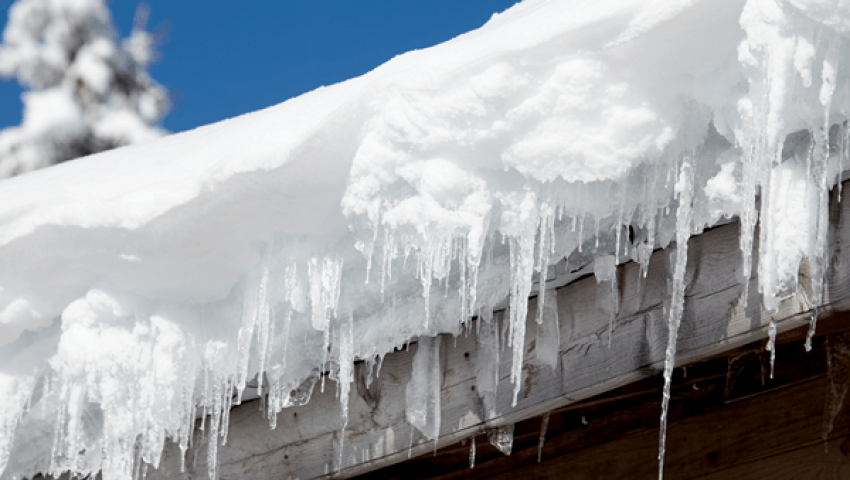The icicles hanging along your roof in the winter look so lovely. But, don’t be fooled. Icicles are signs of ice dams. Ice dams are created when a snow-covered roof gets heated, usually from heat escaping from your attic. The snow melts and then, usually that night, it refreezes into ice. You can see where this is happening by the icicles. These form when the melted snow runs over the unheated eaves and refreezes. The ice gets thicker from all the melting snow and forms a dam. As more snow melts, it gets backed up behind the ice dam and seeps under the shingles. At this point, it can leak through the roof and cause water damage to the decking below the roof and the attic structure. The leaking water can also cause damaged plaster, damaged and peeling paint, and water stains on ceilings and walls. It can also refreeze and cause damage as it expands.
The snow is often melted by heat escaping into a poorly insulated attic. But it can also be heat getting into the attic from penetrations such as:
- • Doors, hatches, and stairways into the attic
- • Chimneys
- • Heating ducts that go through the attic thus heating the air in the attic
- • Shared walls between apartment attics
- • Ceiling light and fan fixtures
- • Dropped ceilings
- • Interior wall gaps
- • Fans vented into the attic instead of outside (these can also cause mold problems in warmer weather)
- • Knee walls (common in houses with a half-storey above the first storey)
- • Electrical penetrations
Existing damage such as hail damage to the roof would also create pathways for the thawing ice to seep.
Prevention of Ice Dams

The best way to prevent an ice dam is to insulate your attic and keep heat from getting into it in the first place. Clean out gutters and downspouts during the non-winter months to facilitate drainage of melted snow. Make sure you have good ventilation in the attic to keep cold air circulating. In the winter, use a roof rake to remove snow from the roof edges. Do this very carefully as the roof rake can cause damage to the roof.
Do not get on the roof if it is covered with snow and/or ice. Let a professional contractor such as Peak to Peak do this. All of our personnel are trained and equipped to do this safely. And do not try to chip away an ice dam with an ice pick. You are sure to damage your roof.
You can also install a heat-enabled cable that sits on the edge of the roof and in the gutters and melts the snow so it can drain. The downside of these is that the constant localized heating and cooling can cause your shingles to deteriorate quicker.
Cover the hatchway into the attic or the whole house fan. These are large areas where heat can escape into the attic. Replace old-style recessed lights, which can’t be insulated, with sealed IC fixtures.
Elimination of Ice Dams
Peak to Peak Roofing and Exteriors can consult with you about ways to prevent ice dams from damaging your roof. A good time to seal air leaks into the roof is when you are having the roof replaced or a renovation being done. The access points that need to be sealed and/or insulated may be easier to reach during this time.
If you suspect damage to your roof, call Peak to Peak for a complimentary roof inspection. We can inspect the flashing around chimneys and replace it, if necessary. We can seal and insulate ducts and caulk penetrations. We can tell you if your roof needs to be repaired or replaced. Replacement may not involve the whole roof but only a damaged section. We will also work with your insurance company if the damage is a result of a condition warranting a claim. At Peak to Peak Roofing, we schedule our re-roofing projects year-round. We want to provide you with the peak of customer service for all your roofing needs, from roof repairs to roof replacement. We have platinum preferred roofing contractor status with Owens Corning which shows that we operate with integrity and provide superior craftsmanship on every roofing project. Contact us today to experience our peak service with your home or business. Leave your ice dam problems with us. And feel free to hang fake, electric-light icicles along your roof, instead.

